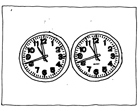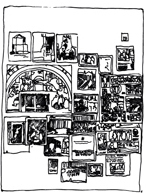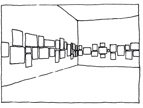An entry
Now when I am assembling this book, moving the pieces around, looking through boxes of material,
negatives, notebooks, I recognize the familiar feeling of getting started on a new work or a new project.
Combining the pieces so that, independently, they are something by themselves while, when united,
they point towards a center, which each piece cannot express by itself.
As an entry to my work, I have chosen to focus on two works from 1997 that represent a point of
departure from where several other works and ideas have been developed. But the subject that
these two works address became part of my life much earlier. Thinking about identity and duality and
the conflicts relating to their definitions is part of the person I am and I think it will always be a central
part of my life.
In 1997, I was visiting the Midwest of the United States, where I was working on a project called
Generated Memory. The basis for the project was an interest in the descendents of the Scandinavian
emigrants and their way of preserving their cultural background.
From 1850 to 1920 there had been a massive emigration from Scandinavia due to famine and poverty,
as was the case in many European countries, and the largest Scandinavian colony was founded in
Minnesota. The question I was exploring was quite simple: How did the third or fourth generation of
emigrants look upon their origins and how did this affect the way they lived?
In the mid-1990s, the tone used by the Danish politicians and media in relation to immigrants was
changing. Denmark, as well as Scandinavia as a whole, had a long tradition of tolerance and humanistic
compassion and the new rhetoric surrounding the immigrants signaled a significant change.
It was a non-reconciling and confrontational rhetoric and the essence of the debate, basically, was
that the immigrants should integrate themselves according to the values that are historically related to
Denmark. The success of their integration was the immigrants’ own responsibility and the preservation
of their original culture, religion or way of life constituted an obstacle to being accepted in their new
native country.
I found this approach to be lacking in empathy, inasmuch as the need to maintain bonds to one’s
culture, religion and background is essential when moving from one culture to another.
It is these values that make it possible to function in the new surroundings and therefore the values
and their importance are handed down to the children of the family as part of the child’s upbringing.
A natural consequence is that families that possess the same or similar cultural backgrounds seek out
each other in order to share their common values. And this is done for purposes of attaining cultural
recognition.
In Minnesota, I visited a large number of families of Scandinavian descent, who were generous
enough to invite me into their homes. It quickly became apparent that the Scandinavian heritage in
Minnesota still stands strong and traditions are upheld much as they are in Scandinavia.
Even more than 100 years after the first immigrants arrived, their offspring still identify with their
ancestors’ cultural background. To me, taking this away from them is impossible.
It is simply an integral part of who they are, as the power of our minds and the memories they hold
are what make us who we are.
As I was working on the project, one recurrent phenomenon stood out: there were small disparities
between the way the emigrants’ descendants in Minnesota and Scandinavians do things. Traditional
food was prepared in a slightly different way, with the use of alternative ingredients, and thus did
not taste exactly as it ’should’. There were small alterations in the traditional Scandinavian music and
even the red and yellow colors of the flags had nuances that differ from what can be found on official
Scandinavian flags. Time had set its mark on the details, and this could be regarded as either an
improvement or a misunderstanding. However, for the descendants of the immigrants everything
was as it was supposed to be.
Acknowledging these differences made me see that the descendants were still trying to adopt and
remember the Scandinavian values but doing this entailed problems and maybe it was not even
fully achievable.
At best, the descendants could achieve a similarity to the ‘original’ or ‘real’, not unlike that of a
representation, but this did not change the fact that the feelings and the sense of connection they
felt about their origins was as genuine as the feelings of the ‘originals’.
While I was working on Generated Memory, I was also working on a film project called Two Similar
Which Are Different. These two projects are connected and they share points of similarity, although
at the time I did not see the connection as I later have come to understand it.
Two Similar Which Are Different is a double-projection of two 16 mm films shown next to each other.
The film’s visual narrative depicts a meeting between a man and a woman that takes place in an
empty apartment. Although the actors are talking, it is a silent meeting, since the film was recorded
without sound. During the filming, the actors were asked to perform each shot twice, with the result
that I ended up with two films, which are edited in the same way and look almost the same.
But small discrepancies in the actors’ movements and expressions render the films different.
The point of the project was not to tell the story of the acting but rather to show that something that
appears to be the same can be different. And what looks different can be close to identical.
This is where the two projects converge and share similarities. Representation and original.
In Generated Memory: the representation, in the form of personal identification. In Two Similar Which
Are Different: the representation as object.
I have always found the question of identity to be complicated and full of conflicts. I regard this as a
consequence of my own background, being Danish, with Swedish and Chilean parents and brought up
in Denmark. For as long as I can remember, I have had thoughts about this issue and it has become as
natural to me as breathing or eating. Making art became a way to generate a better understanding of
my own thoughts but later I have found that these questions also relate to many common conflicts and
problems in our existence.
Conflicts grounded in defining the ‘real’ as part of our attempt to experience and understand life as best
we can.
The works presented in this book have been based on a sense of curiosity that leads to examination,
collection and processing. Exploring ideas through a vast variety of materials in a wish to view the
questions from different angles. Sometimes confirming what I already knew, or even better,
sometimes unfolding the questions and understanding them in a new way.
At times, I have been yearning for a kind of absorption, in the common sense of the word, but that
might also have led to repetition and copies.
To me, a representation is a much more complex matter than a copy. The copy only wishes to acquire
the originality of the original, to be regarded as ‘real,’ whereas the representation is connected – and
constantly refers – to the original. The representation is something because of the original, while the
original becomes an original due to the existence of the representation.
This dependency is of a symbiotic nature: a dependency that is valid at its core for numerous issues
related to existence and imbues both parts in the symbiotic relationship with something additional
to their individual existences. This positive influence stands in stark contrast to the copy’s detailed
repetition to obtain what it cannot obtain by itself.
Questions about the real and representation, conflict and balance and identity and existence are
present in many of my works and I consider this to be a consequence of the continuous relevance of
these questions to me. But I still try to see each of my works as an individual entity, and most of the
time, what my next work will be is unclear to me.
In recent years, I have occasionally stated that whatever work I was presently working with would be
my last. This has provided a needed feeling of space for moving within as well as not having to look too
far ahead. And somehow, it has caused me to ask new questions that I have felt were worth pursuing.
Henrik Capetillo 2010
A note
Sometimes I have found texts or works that were meaningful to the thoughts I had been exploring,
since they caused me to see my ideas in a different way. It’s something like rediscovering your own
work when you accidentally come across other persons, previously unknown to you, who, in their
writings describe a thought you had and which you were certain was your own.
This can be both a comforting and a disillusioning feeling; comforting insofar as we all seem to share
much more than we are generally told we do and disillusioning inasmuch as history appears to be
repeating itself. Although this, of course, is impossible.
There is one particular work that I have thought about while writing this text, Mnemosyne Atlas, by
the German art historian, Aby Warburg. Mnemosyne means remembrance; in Greek mythology, it
stands as the name of the goddess of memory.
The work addresses questions that seem fundamental to any kind of collection, whether it is an
installation or a book or something similar. How do you arrange it and how much do you want to
explain? If anything at all.
Warburg created this work in the early 20th century and it can be considered one of the first modern art
installations. It is a series or collection of collages in which Warburg wished to capture a collective social
memory through complex combinations of images and texts: a mapping of something that is diffuse
and difficult to define.
When looking at the documentation photos, the first impression that enters your mind is that the Atlas
looks like large message boards with photos and clippings and they are arranged in such a way that the
boards open up to the collective memory.
Although Aby Warburg had planned to add textual commentaries to each panel, these were never
completed as his death left the work unfinished. The lack of textual explanation is vital to how I see
his work. It’s almost as though it were intended to be like this.
Assuming that Aby Warburg wished to access a collective social memory, this might have been the
only way it could be accomplished: through a non-verbal approach.
The work would have to be self-explanatory, with no verbal disruptions, for the beholder to be able
to access the layers of the consciousness that are incompatible with verbalization.
“I have nothing to say. Only to show” as Warburg’s ‘student’, Walter Benjamin, has later been quoted.
This approach to art borders on shamanic behaviour, where sensing is the way things are understood.
Even though it is debatable whether Warburg was interested in the metaphysics of a shaman, I still
think that this is an aspect of the work he left behind.
Perhaps I am altering the work into something it was never meant to be but that, I believe, might well
have been part of the intention of the Mnemosyne Atlas.
•
•
•
•
Conflict and Balance
An entry (English)
Conflict and Balance
En indgang (Danish)
Text
Biography
Book
Drawing of Jim Shaw's
Thrift Shop Paintings, 1990

Drawing of Felix Gonzalez-Torres'
Untitled (Perfect Lovers), 1991

Drawing of Joseph Kosuth's
One and Three Chairs, 1965

Drawing of Aby Warburg's
Mnemosyne Atlas, No. 79,
1924-1929
